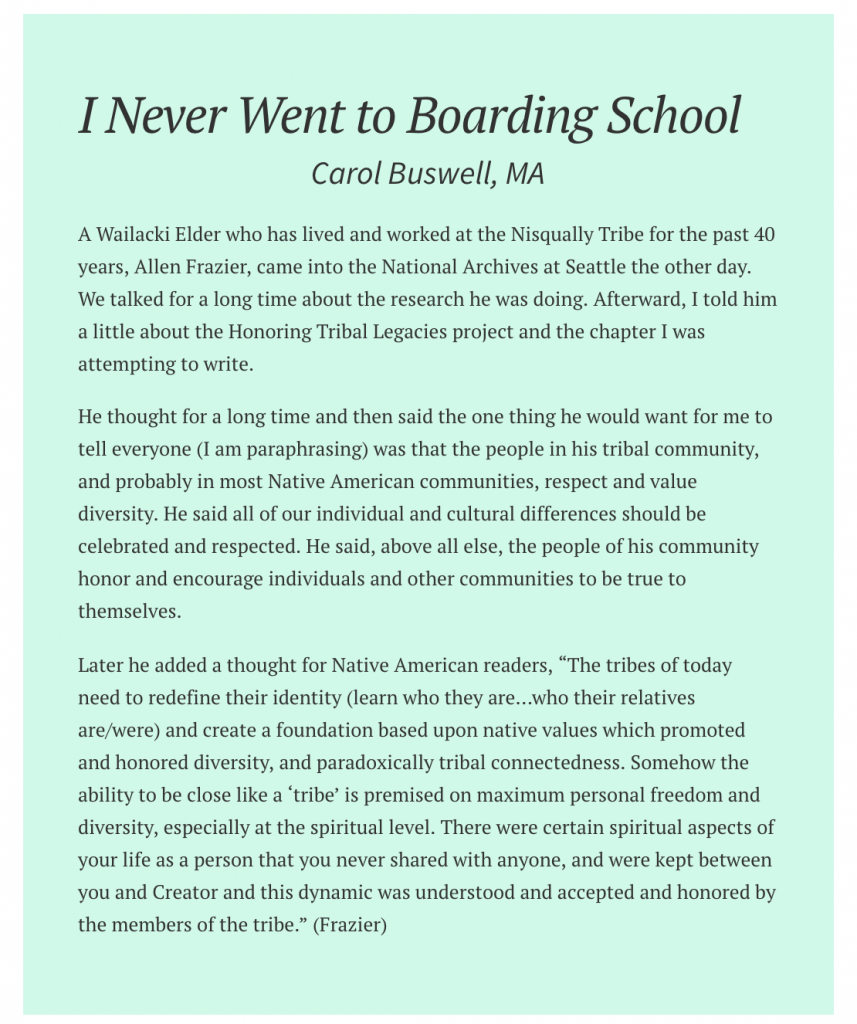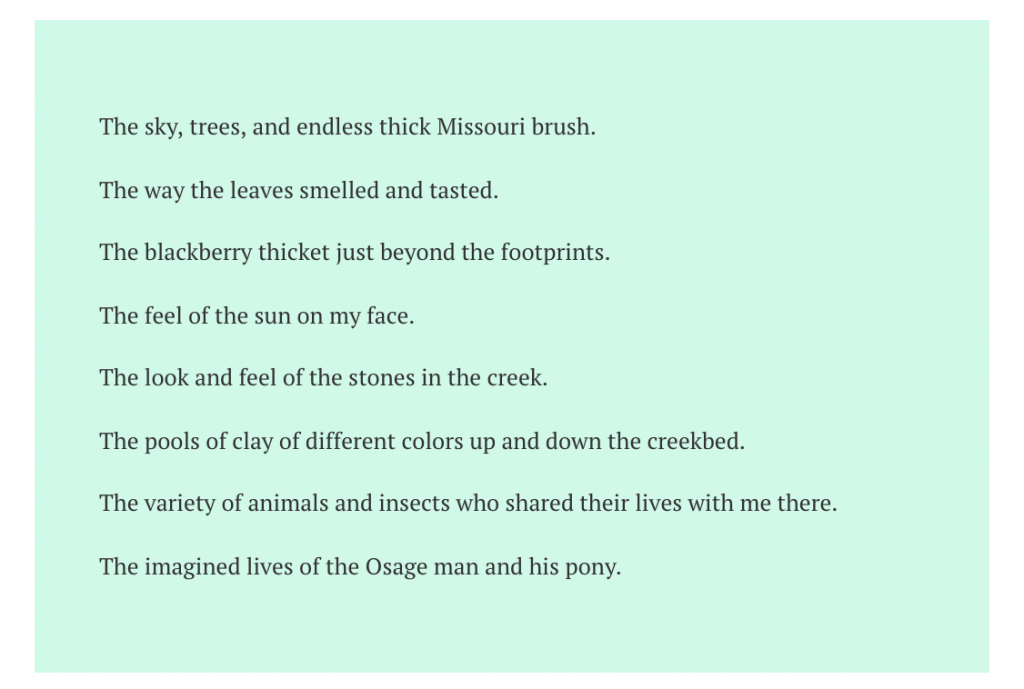(This is a preamble to Carol Buswell’s curriculum unit, “Exploring Your Community.”)

In the spirit of being true to myself, I must tell you that I am pretty old. This is something we brag about in my multiracial family. Unfortunately, since I am not culturally Native American, I don’t have the honor of being considered an Elder. In the nonIndian culture I seem to be less and less valuable to society in general as time goes by. I often talk too much and say ridiculous things, especially when I am nervous. This seems to be getting worse the older I get. However, on the bright side, I am never at a loss for words, no matter how inappropriate.
I am one of about twenty Education Specialists for the National Archives in Washington D.C., and have been stationed at the Seattle facility for a little over eight years. I hold a Master’s Degree in American Indian Studies and experience as a family historian. The Archives has millions of American Indian records and lots of people of all nationalities wanting help with their family history. I also have a degree in Elementary Education and taught sixth grade in Colorado, California, and Oregon for several years. I love kids, teaching, and American Indian history.
My father was an amateur family historian. The day I graduated with my Bachelor’s degree, he announced that, due to my advanced education (he had only gone through the 9th grade), I was now in charge of finding our Cherokee ancestors. Primarily of Scotch, Irish, German, and English descent, my father had been told that he also descended from two Cherokee great grandfathers. According to the family story, Dad’s paternal great grandfather walked the Trail of Tears. The records show his grandfather as a 13-year old boy living with soldiers who had walked the Trail. This seems to indicate truth in the family story, however there is no written indication of nationality in any record.
The other great grandfather fought with the Cherokee troops against the Red Stick Creeks in the War of 1812. He and his brother lived with their white father. His sister went back to the tribe to live with their mother. Both of these great, great grandfathers married white women.
My family has been disappointed by my assurances that we cannot become citizens of the Cherokee Nation or the Eastern Cherokee Band. This is because, like many other people with very small amounts of Indian blood, our ancestors left the tribe, lived lives of pioneers and settlers portrayed in most history books, became American citizens, and lost their tribal citizenship long before enrollment or allotment. They “turned American.” Back in the mid 1800’s our ancestors became regular landowning farmers in Missouri, where it was illegal for American Indians to move into the state from any other location (Bunch). There were stiff penalties, including possible deportation across the nearest border within 24 hours. I am assuming that is why my family kept their Cherokee ancestry very quiet and only spoke of it among themselves.
Because of this, my family also avoided the hardships and discrimination suffered by the tribal members who fought to keep their communities and culture together. My family members did not have to obey laws specific to Native Americans. They were not murdered on sight for merely being an Indian. Nobody in my family ever went to an Indian boarding school where small children were taken from their loving families to a strange place and forced to live a completely nonIndian life or, when finally allowed to go home, sometimes found they no longer really belonged.
1See: Pevar, Stephen L. The Rights of Indians and Tribes: The Basic ACLU Guide to Indian Tribal Rights, 2d edition, Southern Illinois University Press, 1992; Price, Monroe E., Robert N. Clinton and Nell. J. Newton. American Indian Law: Cases and Materials, 4th ed. Charlottesville, Virginia: LEXIS Law Publishing, 2001; Wilkinson, Charles F., American Indians, Time and the Law: Native Societies in a Modern Constitutional Democracy. New Haven: Yale University Press, 1988. Prucha, Francis, ed.; Documents of US Indian Policy. University of Nebraska Press. 2001.
2See: Matthews, Betty. Murder as a Policy. Lewis and Clark Trail Tribal Legacy Project.
3See: Bear, Charla: National Public Radio broadcast, May 12, 2008, Smith, Andrea, “Soul Wound: The Legacy of Native American Schools”. Amnesty International USA and many others.
Although not qualified to be a tribal member, I am very proud of my Cherokee ancestors. I have been fascinated with the tribe since I was a small child on a Missouri farm, listening to whispered family stories. My fascination with all things Native American grew when one summer, after a big flood, I discovered a huge, flat stone with perfect foot/hoof prints of someone walking down the creek bed with his pony. We lived in what, of course, had been Indian country and often found arrowheads on our farm. The prints in the rock were obviously very, very old. My imagination completely ran away with me. I loved that stone record. I practically lived in the creek every summer day for the nine years we were there. I wove stories around the life of the Osage man who I assumed had made the prints. Maybe he was hunting or hiding from someone. Maybe he was escaping from another tribe or from the United States Army.
This was where I became fascinated with Native Americans, history and records of all kinds. It was where I learned to honor “place” as well. To me, there is no place on earth as fascinating as that huge flat stone at the bottom of the creek bed. When we sold the property to my cousin, he put three feet of gravel on top of the stone so cars could cross the ford nearby more easily. Even so, I can remember everything as if it was just yesterday.

When my family left the farm, I kept looking for more understanding about Native American life and peoples. No matter where we lived, I searched out classes. One university counselor, after looking at my many transcripts, asked if I was on the “Western Tour of Colleges.” Eventually, I found myself in graduate school at UCLA in the American Indian Studies department.
I have had many jobs in my life, classroom teacher, secretary, writer, genealogist, antiques dealer, desktop publisher, and even a nurse’s aide. However, working at the National Archives has been one of my favorites. There are nearly forty thousand cubic feet of original records in the room next to my office and I can search them any time I want. Seven thousand of those cubic feet contain Bureau of Indian Affairs records. I have the privilege of supervising students and volunteers who want to know how to search those records as well. My students and I have discovered countless historical facts not known by anyone before we stumbled upon them in the Archives. For us, the thrill of each new discovery is very much like walking on the moon.
Even as a graduate student, I was enamored with the endless possibilities lying in the gray acidfree boxes in the back of the Archives. At that time I discovered that by 1911 thousands of Cherokee Indians lived in 48 states and seven foreign countries, including what was then Syria (Buswell).
The Archives is all about exploration and discovery. One of my students discovered that the Bonneville Dam on the Columbia River between Oregon and Washington might have turned out to look like a sculpture of Paul Bunyan and his ox, Babe, had they not run short of funds. The records held schematics, drawings, and a photographed copy of a smallscale sculpture of Paul and his ox. We have many stories like this. The Archives stores the “permanent” records of the federal government. These are mostly papers from the desk files of government employees and administrators. Most of these records have not been touched for a hundred years or more.
4Photographs of the sketch and model of the proposed dam can be seen at Bonneville Office Correspondence and Reports, 1933-1940; Second Portland District Office; Records of the Office of the Chief of Engineers (RG 77)
I find it a great honor to be invited to participate in the production of the Honoring Tribal Legacies Handbook with such an esteemed group of scholars. I especially love sitting in a circle with them, listening to both ancient and modern oral histories, and being enveloped by their wonderful, infectious humor. I love to feel the special spirit that nearly always attends. I always feel honored to be invited to any gathering. I never feel out of place for very long. I usually talk too much and sometimes embarrass myself by saying really stupid things, but the group is always respectful. Their respect for individual diversity is obvious and palpable. I hope to become a little more like them every day. In my opinion, what we all need is respect for who we are, what we believe, and what we know. We need to seek for an understanding that reaches beyond our own experience, and to love our differences as much as we delight in our similarities.
